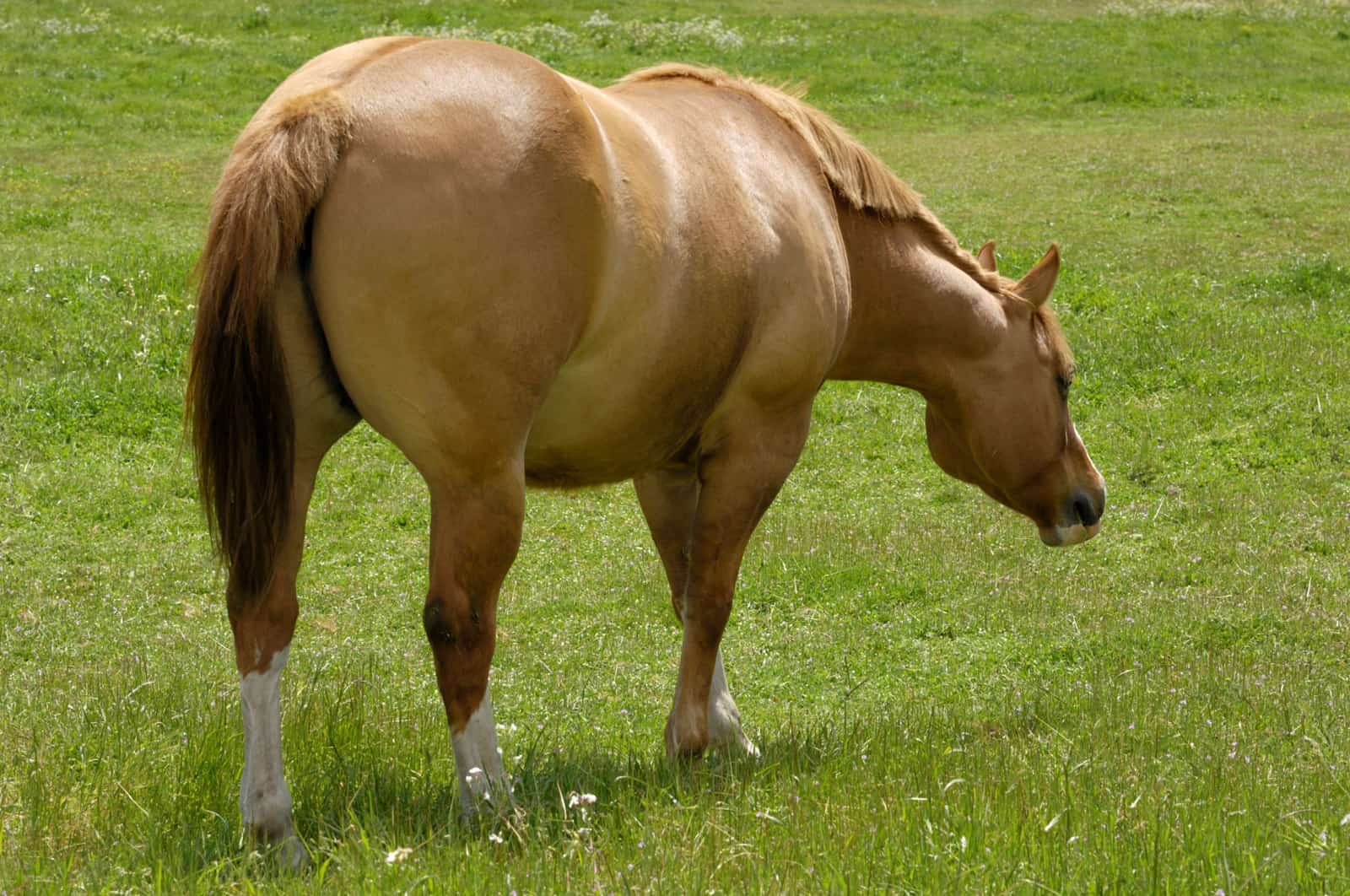Controlling Obesity in Horses

Obesity in horses can lead to a plethora of health problems, including insulin dysregulation, increased laminitis risk, reproductive concerns, post-surgical complications, orthopedic issues, asthma, and more. Nonetheless, the condition remains widespread; researchers have reported around 30% of horses are overweight.
At the 2022 ACVIM Forum, held June 22-25 in Austin, Texas, Megan Shepherd, DVM, PhD, Dipl. ACVIM (Nutrition), of Veterinary Clinical Nutrition, in Christiansburg, Virginia, described her recommendations and research-based ideas on how to manage equine weight.
Forage Percentage
Generally, horses should consume 2% of their body weight in forage dry matter daily. If a horse has been offered more than this, cutting back can help promote healthy weight loss. Ideally, when reducing forage for a horse, weigh each portion (such as with a hanging fish scale) to meet the daily allowance. This can be tricky when feeding horses in group settings, however. In those situations grouping horses by body condition score (BCS, which falls on a scale of 1 to 9) and then rounding hay portions to the closest 1/4-1/2 bale (after calculating average bale weight) can help regulate overall herd weight.
Sometimes, feeding 2% of the horse’s weight in daily forage is too much. If the horse is still gaining weight or not losing weight, Shepherd said cutting back forage by 10-20% can help. Reducing forage intake to only 1% of the horse’s body weight might even be necessary. She told The Horse that owners should consider working with a nutritionist at this point, if not sooner.
Shepherd said if forage is the sole protein source in the horse’s diet, it is crucial to ensure it contains enough protein to meet his needs. Protein helps the horse maintain and build muscle mass, which is crucial for easy keepers on a diet. Lack of muscle has a negative effect on metabolism, which in turn is detrimental to helping a horse shed excess fat tissue.
Pasture Forage Challenges
Unlimited pasture access can be a challenge when monitoring easy keepers. Pasture can increase horses’ nonstructural carbohydrate (NSC) and calorie intake, which increases laminitis risk. Nonstructural carbohydrate levels are influenced by several factors, including sunlight, freezing temperatures, poor soil fertility, and the region where the horse resides. Simply turning an overweight horse out for a shorter amount of time might not reduce his NSC consumption, as many horses simply increase their grazing rate during the abbreviated pasture time. Therefore, a grazing muzzle is a better option. Muzzles reduce a horse’s intake by 30-80%, said Shepherd, while still allowing overweight horses the benefit of voluntary activity that turnout allows.
Evaluating the Current Diet
“The current diet provides huge context into what needs to happen to get the weight off the horse,” Shepherd said.
If the horse has been allowed unlimited forage, “simply limiting intake can make all the difference.” She said horses have been observed eating up to 5.5% of their weight daily in forage dry matter when unrestricted.
Hay is easier to measure than pasture, of course. The weight of a flake of hay can vary considerably, so be sure to weigh portions before feeding.
Slowing it Down
Slowing consumption and dividing food into multiple portions throughout the day can be beneficial, said Shepherd. However, some horses still eat their forage too quickly, leaving them without it for an extended period. She recommends using a slow-feed haynet to encourage horses to take their time eating. In circumstances where the horse is still eating too quickly, doubling up haynets is an option. This will reduce the time between meals for overweight horses while still decreasing intake, which supports both mental and gastrointestinal health.
Concentrate Feed in Addition to Forage
Often, forage alone doesn’t meet a horse’s nutrient needs. So what can you safely add for an easy keeper?
Shepherd said selenium levels vary greatly in forage because the mineral comes from the soil. If the forage is selenium-deficient, feed or ration balancer can provide what’s missing. She said fat-soluble vitamins are plentiful in fresh forage but not in hay, so adding a vitamin and mineral product can help fill these voids.
Essentially, owners should “ensure that the forage is complemented with a proper source of essential micronutrients,” she told The Horse. Ration balancers are designed to meet horses’ nutritional requirements without adding the calories a concentrate would provide. Most balancers contain around 30% protein (as fed), which makes them good options for feeding horses that aren’t getting enough protein from forage. Additionally, ration balancers provide a base for owners to top-dress with supplements or medications.
Making a Practical Plan
Shepherd said the best way to manage obesity is by preventing it. Establish good feeding habits—keeping your horse’s healthy weight in mind—and stick with them long-term to help prevent or limit weight gain before it becomes detrimental.
Shepherd recommends assessing your horse’s weight and body condition every two to four weeks. Generally, a healthy weight loss goal is 0.5-1.0% of the horse’s body weight per week, which translates to 0.5-1/9 BCS loss monthly.
Considering the horse’s circumstances and job is important when making a practical plan, she added. For horses in work, it is crucial to ensure they are getting their necessary protein, vitamin, and mineral needs while consuming fewer calories. If a horse has dental problems, you might also have to think about forage form (such as adding grass hay pellets).
For a horse’s weight control plan to be effective, everyone who takes care of the horse must be on the same page. A nutritionist can make suggestions, but owners and caregivers must follow through with the plan. If, as an owner, you have concerns about your horse’s diet, mention them to your veterinarian. Sometimes it’s simply not practical to restrict a horse’s pasture access. In these situations, it’s essential to have open conversations about what can work well and be practical for everyone involved.

Written by:
Shoshana Rudski
Related Articles
Stay on top of the most recent Horse Health news with












